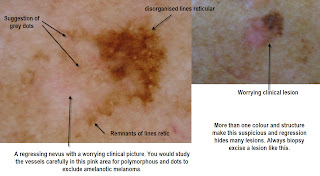

Choroidal melanomas affect light-skinned persons in the sixth or seventh decades of life and are the most common primary intraocular cancer in adults. If enlargement or elevation of the nevus is noted, then malignant transformation into a choroidal melanoma should be suspected.
COLORDIAL NEVUS SERIAL
Photodocumentation with serial fundus photography is an excellent way to monitor for any growth. The nevi stand out more clearly against the red fundus background with pupillary dilation.


The best management of a choroidal nevus is yearly examination through a dilated pupil. More rarely, choroidal nevi can be associated with overlying cystic degeneration of the retina, neovascular membranes, subretinal serous fluid, and visual field defects-especially if the nevus is located in the macular area. Most choroidal nevi are benign, but they can grow into a malignant melanoma. Occurring most often in the choroid, the pigmented layer beneath the retina, a choroidal nevus can only be seen by an eye care specialist. Nevi that develop in this layer are choroidal nevi. What is a Choroidal Nevus Just like on your skin, a raised freckle (or nevus) can occur inside your eye. Behind the retina is the choroid, a layer of blood vessels that bring oxygen and nutrients to the eye. These drusen are a good indicator of age and inactivity. A choroidal nevus is usually a pigmented tumor of the blood vessel layer called the choroid, which is beneath the retina. Nevi (the plural of nevus) can develop under the retina, the specialized nerve tissue lining the back of the eye that detects light and color. Typically flat or minimally elevated, variably pigmented, and slate-gray to black in color with overlying yellow drusen on their surface. Close inspection through a dilated pupil revealed no change in the size or shape of the nevus from clinical fundus photographs taken of the same lesion more than 10 years earlier.Ī choroidal nevus is a benign pigmented tumor composed of melanocytic cells. She also had a history of a choroidal nevus in her right eye. She had a history of previous cataract surgery with pseudophakia and mild dry age-related macular degeneration. An 83-year-old woman presented for her annual eye examination.


 0 kommentar(er)
0 kommentar(er)
